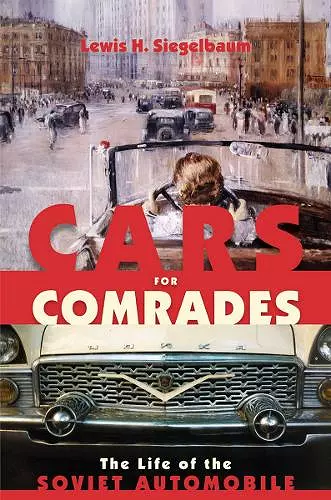Cars for Comrades
The Life of the Soviet Automobile
Format:Paperback
Publisher:Cornell University Press
Published:15th Apr '11
Should be back in stock very soon

The automobile and Soviet communism made an odd couple. The quintessential symbol of American economic might and consumerism never achieved iconic status as an engine of Communist progress, in part because it posed an awkward challenge to some basic assumptions of Soviet ideology and practice. In this rich and often witty book, Lewis H. Siegelbaum recounts the life of the Soviet automobile and in the process gives us a fresh perspective on the history and fate of the USSR itself.
Based on sources ranging from official state archives to cartoons, car-enthusiast magazines, and popular films, Cars for Comrades takes us from the construction of the huge "Soviet Detroits," emblems of the utopian phase of Soviet planning, to present-day Togliatti, where the fate of Russia's last auto plant hangs in the balance. The large role played by American businessmen and engineers in the checkered history of Soviet automobile manufacture is one of the book's surprises, and the author points up the ironic parallels between the Soviet story and the decline of the American Detroit. In the interwar years, automobile clubs, car magazines, and the popularity of rally races were signs of a nascent Soviet car culture, its growth slowed by the policies of the Stalinist state and by Russia's intractable "roadlessness." In the postwar years cars appeared with greater frequency in songs, movies, novels, and in propaganda that promised to do better than car-crazy America.
Ultimately, Siegelbaum shows, the automobile epitomized and exacerbated the contradictions between what Soviet communism encouraged and what it provided. To need a car was a mark of support for industrial goals; to want a car for its own sake was something else entirely.
Because Soviet cars were both hard to get and chronically unreliable, and such items as gasoline and spare parts so scarce, owning and maintaining them enmeshed citizens in networks of private, semi-illegal, and ideologically heterodox practices that the state was helpless to combat. Deeply researched and engagingly told, this masterful and entertaining biography of the Soviet automobile provides a new perspective on one of the twentieth century's most iconic—and important—technologies and a novel approach to understanding the history of the Soviet Union itself.
Cars for Comrades is a complex, sophisticated, and entertaining history of cars and trucks in the Soviet Union.
* Business History Review *A groundbreaking chronicle of the contradictory, faltering, and fascinating march toward automobilism in the USSR.
-- Tom Vanderbilt * Times Literary Supplement *Lewis H. Siegelbaum explores the curious antinomy between the car and Communism. On the one hand, the production of cars was a symbol of Communism. The building of car-producing factories was an important criterion for catching up with and surpassing America. On the other hand, almost nobody had a car in their personal possession in the early Soviet years. The production itself was important, not the result, which is not surprising if we take into account that a car was a symbol of personal independence.
* Slavic and East European Journal *Siegelbaum has produced a superb account of Soviet life as viewed through the lens of the failed Soviet struggle to match the capitalist West, and the United States in particular, auto for auto and highway for highway, while denying its citizens the mobility that would undermine the Soviet state.... The book is a pleasure to read and... brings an important part of the history of the Soviet Union to light by illustrating the day-to-day workings of its economic system.
-- Andrew Morriss * Books & Culture *Siegelbaum's book is impressive. It deserves to be heralded by a whole Moscow traffic-jam full of tooting horns.
* American Historical Review *This is a statistic-rich volume, but, as Siegelbaum acknowledges, the Soviet statistic is slippery and sometimes misleading. Statistics may be plentiful, but facts are somewhat patchy, and the strength of Siegelbaum's approach lies in his skillful interweaving of numerical evidence and exegesis, bolstering massaged official figures and incomplete data with textual and visual sources: memoirs, anecdotes, transcripts, reports, publications, paintings, films, photographs, and a variety of other archival materials. This inclusive approach carries the reader on raised suspension over the worst potholes and inconsistencies in the road surface.
-- Oliver Johnson * Journal of Cold War Studi- Winner of Distinguished Contributions to Slavic, East European, and Eurasian Studies Award 2024 (United States)
- Commended for Reginald Zelnik Book Prize in History 2009 (United States)
ISBN: 9780801477218
Dimensions: 235mm x 155mm x 19mm
Weight: 907g
328 pages